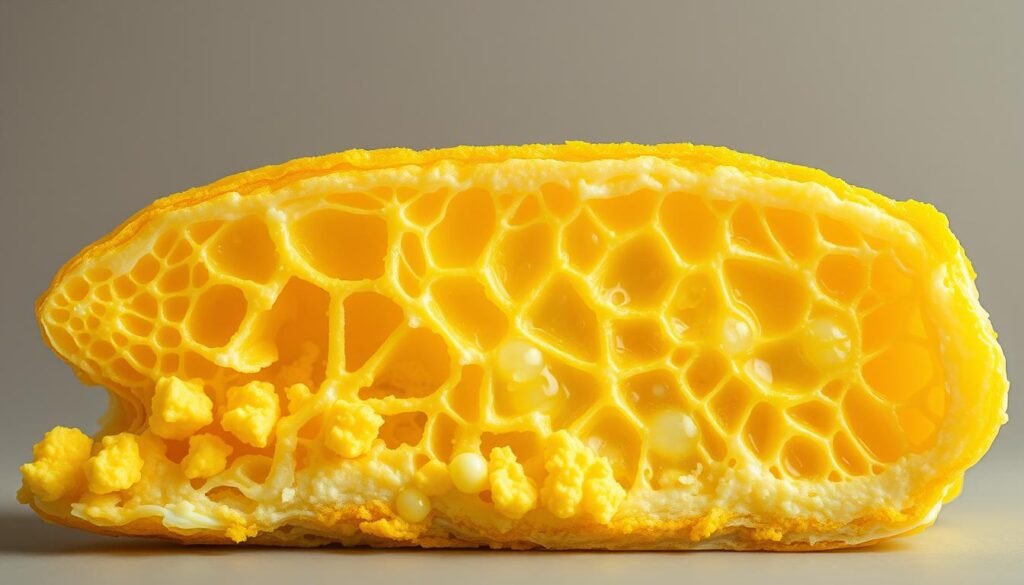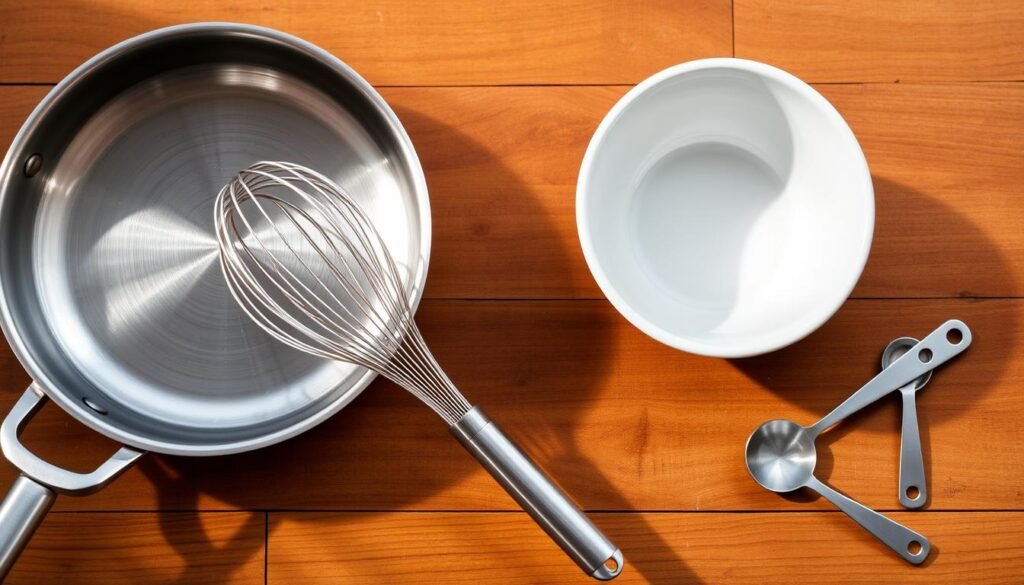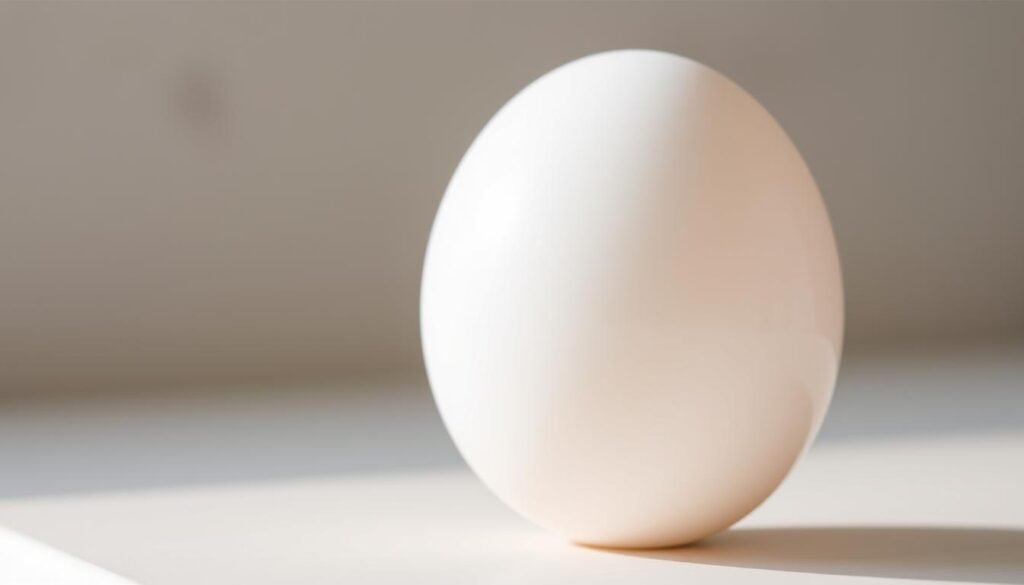Scrambled eggs are a favorite in many breakfast recipes. They are tasty and packed with protein, making them a great way to start the day. But, making perfect scrambled eggs is more than just cracking eggs into a pan. It takes skill, the right ingredients, and practice.
In this guide, we’ll show you how to make fluffy, tender scrambled eggs. These will make your mornings better.
Whether you’re new to cooking or have lots of experience, our guide has tips for you. You’ll learn how to make scrambled eggs like a pro.
Key Takeaways
- Understand the importance of using fresh eggs for the best flavor.
- Learn the technique for whisking eggs to the right consistency.
- Discover the ideal heat and cooking time for perfect scrambled eggs.
- Explore additional ingredients to enhance the flavor of your scrambled eggs.
- Master the art of serving scrambled eggs for a delicious breakfast.
The Science Behind Perfect Scrambled Eggs
To make perfect scrambled eggs, you need to understand protein coagulation and fat content. This knowledge turns a simple dish into a culinary masterpiece.
Protein Coagulation and Texture Development
The texture of scrambled eggs comes from protein coagulation when heated. Egg proteins bond together, creating the egg’s structure.
Heat Effects on Egg Proteins
Heat makes egg proteins denature and coagulate. How fast and how much they coagulate affects the egg’s texture.
Creating the Ideal Curd Structure
To get the perfect curd, control the heat and stirring. Gentle heat and minimal stirring make the eggs soft and moist.
The Role of Fat in Flavor and Moisture
Fat is key for flavor and moisture in scrambled eggs. It adds taste and makes the eggs creamy.
Why Fat Content Matters
The type and amount of fat used matter a lot. The right fat balance is needed for the perfect taste and texture.
Emulsion Science in Scrambled Eggs
Emulsion science is important when adding fat to eggs. A stable emulsion ensures even fat distribution, leading to uniform texture and flavor.
| Factor | Effect on Scrambled Eggs |
|---|---|
| Heat | Affects protein coagulation and texture |
| Fat Content | Enhances flavor and moisture |
| Stirring | Influences curd structure and texture |

Essential Equipment for Scrambled Egg Success
Making perfect scrambled eggs needs more than just eggs. You need the right cooking equipment. The quality of your cookware and utensils greatly affects the outcome.
Choosing the Right Pan
The pan you pick is key to your scrambled eggs. Material and size are very important.
Non-Stick vs. Cast Iron vs. Stainless Steel
Non-stick pans are best for delicate eggs. They prevent sticking and are easy to clean. Cast iron pans heat evenly but need seasoning and are heavy. Stainless steel pans are tough and scratch-resistant but might need more oil.
Pan Size and Shape Considerations
A pan that’s too small makes eggs too dense. A pan that’s too big makes them too thin. Look for a pan with a flat bottom and sloping sides for perfect scrambled eggs.

Utensils That Make a Difference
The right utensils make making scrambled eggs easier.
Silicone vs. Wooden Spatulas
Silicone spatulas are heat-resistant and gentle on non-stick pans. Wooden spatulas are a good choice but might not last as long.
Whisks and Beating Tools
A whisk is key for beating eggs well. You can also use a fork or an electric mixer for fluffier eggs.
Heat Source Considerations
The heat source changes how your scrambled eggs turn out.
Gas vs. Electric Cooking Surfaces
Gas stoves offer precise temperature control. Electric stoves are consistent but lack the quick adjustability of gas.
Temperature Control Methods
Using a thermometer helps get the perfect temperature. Some pans have built-in temperature control.
Selecting Quality Ingredients
Making great scrambled eggs starts with choosing the right ingredients. The freshness and type of ingredients greatly affect the taste, texture, and quality of your dish.
Egg Freshness and Quality Indicators
The freshness of eggs is key for excellent scrambled eggs. Fresh eggs taste better and have a better texture.
Decoding Egg Labels and Grades
Eggs are labeled and graded for quality and freshness. Knowing these labels helps you pick the best eggs.
Storage Impact on Egg Quality
Storing eggs properly is important for their quality. Keep eggs in the fridge at a cool temperature.
Dairy Options and Their Effects
The dairy you add to scrambled eggs changes their flavor and texture.
Milk vs. Cream vs. Crème Fraîche
Different dairy products change the richness and creaminess of scrambled eggs. Milk adds moisture, cream adds luxury, and crème fraîche adds tanginess.
| Dairy Product | Fat Content | Effect on Scrambled Eggs |
|---|---|---|
| Milk | Low | Adds moisture |
| Heavy Cream | High | Adds richness and luxury |
| Crème Fraîche | Medium | Adds tanginess and creaminess |
Fat Percentage and Texture Outcomes
The fat in dairy products changes the texture of scrambled eggs. More fat means creamier eggs.
Salt and Seasoning Selection
Seasoning is key to making tasty scrambled eggs.
When to Add Salt (Before or During Cooking)
Adding salt at the right time boosts flavor. Some chefs add salt before cooking to break down eggs. Others add it while cooking.
Herbs and Spices That Complement Eggs
Many herbs and spices enhance egg flavor. Chives, parsley, and paprika are popular choices.

Classic French vs. American Scrambled Eggs
Making scrambled eggs is an art that varies by culture. French and American styles are known for their unique techniques and tastes. Knowing these differences helps you pick the right method for your taste and cooking style.
French Technique: Slow and Creamy
French scrambled eggs are famous for their creamy texture and deep flavor. This is thanks to a low heat and constant stirring method.
Low Heat and Constant Stirring Method
Cooking eggs over low heat and stirring constantly stops big curds from forming. This results in a smooth, custard-like texture.
Achieving the Soft Custard Texture
Getting this texture requires patience and gentle stirring. It ensures the eggs cook slowly and evenly.
American Style: Quick and Fluffy
American-style scrambled eggs are fluffier and more voluminous. This is thanks to a higher heat approach.
Higher Heat Approach
Cooking eggs over higher heat makes larger, fluffier curds. This is what makes American-style scrambled eggs so characteristic.
Creating Larger, Fluffier Curds
By cooking the eggs for a bit longer without stirring, bigger curds form. This gives the dish its signature fluffy texture.
Which Method Suits Your Preference?
Your choice between French and American scrambled eggs depends on your texture and time considerations.
Texture and Time Considerations
If you like a creamy, soft scramble and don’t mind spending time, go for the French method. For a quicker, fluffier scramble, choose the American style.
Serving Suggestions for Each Style
French scrambled eggs go well with delicate foods like smoked salmon. American-style eggs are better with heartier options like bacon or sausage.
Step-by-Step Guide to Creamy Scrambled Eggs
Making creamy scrambled eggs is all about the right ingredients and cooking techniques. This guide will help you make perfect scrambled eggs every time.
Preparing Your Ingredients
First, prepare your ingredients well. This step is key to the texture and taste of your scrambled eggs.
The Whisking Technique
Whisking is important. It adds air to the eggs and makes them tender.
Temperature Control During Cooking
Controlling the temperature is key when cooking scrambled eggs. It ensures they cook slowly and evenly, making them creamy.
Knowing When to Remove from Heat
Knowing when to stop cooking is important. You want your eggs to be just set and moist.
| Cooking Method | Heat Level | Doneness |
|---|---|---|
| Slow Cooking | Medium-Low | Just Set |
| Medium Cooking | Medium | Slightly Moist |
| Fast Cooking | High | Overcooked |
Common Mistakes to Avoid
Making perfect scrambled eggs is about avoiding mistakes as much as following the right techniques. Even experienced cooks can fall into bad habits that affect the quality of their scrambled eggs.
Overcooking: The Number One Enemy
Overcooking is a common mistake when making scrambled eggs. It makes the eggs dry and rubbery, which is unpleasant to eat.
Signs Your Eggs Are Overcooking
Watch for eggs that start to brown or develop a rubbery texture. If you notice these signs, it’s time to take action.
Recovery Techniques
If you catch your eggs overcooking, remove them from the heat immediately. Stir in a bit of cold butter or cream to stop the cooking process.
Seasoning Errors That Ruin Texture
Seasoning is key, but doing it wrong can mess up the texture of your scrambled eggs.
Salt Timing Issues
Adding salt too early can make the eggs watery. It’s best to salt just before serving.
Ingredient Balance Problems
Too much of any ingredient, like dairy or herbs, can upset the balance of flavors and textures.
Heat Management Problems
The heat at which you cook your scrambled eggs greatly impacts their quality.
Too Hot vs. Too Cold Cooking Surface
A surface that’s too hot can cook the eggs too quickly, leading to an uneven texture. On the other hand, a surface that’s too cold can result in soggy eggs.
Inconsistent Heat Distribution
Make sure your pan is heated evenly before adding the eggs. Using a pan with a heavy bottom can help distribute heat more consistently.
Favorite Scrambled Egg Breakfast Recipes for Every Taste
Scrambled eggs are incredibly versatile. We’ve picked out a variety of recipes to suit every taste. Whether you prefer something simple or something more complex, we’ve got you covered.
Classic Scrambled Eggs with Herbs
Adding herbs to scrambled eggs can make a big difference. Herbs like parsley, chives, or dill can turn a basic dish into something special.
Fresh vs. Dried Herb Options
Fresh herbs add more flavor and aroma than dried ones. Try using chives or parsley for the best taste.
Herb Combinations That Shine
Try mixing different herbs for exciting flavors. For example, chives and parsley or dill and tarragon can create unique tastes.
Cheese-Infused Variations
Cheese and eggs are a perfect pair. Adding cheese to scrambled eggs can make them richer and more flavorful.
Soft Cheese Integration Methods
Soft cheeses like cottage cheese or cream cheese can be blended into eggs for creaminess. Just crumble or mix the cheese into the eggs before cooking.
Hard Cheese Techniques
Hard cheeses, such as Parmesan or Cheddar, can be grated over the eggs. This adds a burst of flavor during or after cooking.
Protein-Packed Scrambles
Looking to increase your breakfast’s protein? Adding various protein sources to scrambled eggs is a great idea.
Meat Additions (Bacon, Ham, Sausage)
Adding cooked meats like bacon, ham, or sausage boosts protein and flavor. Make sure the meat is cooked before mixing it with eggs.
Vegetarian Protein Options
Vegetarians can use tofu, tempeh, or mushrooms to add protein. Marinate and cook these ingredients before adding them to your scrambled eggs.
| Recipe | Main Ingredients | Protein Content |
|---|---|---|
| Classic Scrambled Eggs with Herbs | Eggs, Fresh Herbs, Salt, Pepper | 18g per serving |
| Cheese-Infused Scrambled Eggs | Eggs, Cheese (Soft or Hard), Salt, Pepper | 22g per serving |
| Protein-Packed Scrambled Eggs with Bacon | Eggs, Bacon, Salt, Pepper | 30g per serving |
| Vegetarian Protein-Packed Scrambled Eggs | Eggs, Tofu, Mushrooms, Salt, Pepper | 25g per serving |
Healthy Adaptations for Dietary Needs
Scrambled eggs can fit many dietary needs, like low-cholesterol or dairy-free. They’re a flexible breakfast option. This makes them perfect for a healthy breakfast.
Low-Cholesterol Options
There are ways to enjoy scrambled eggs without worrying about cholesterol.
Egg White Scrambles
Choosing egg whites over whole eggs lowers cholesterol. Egg white scrambles taste great with the right spices.
Cholesterol-Reducing Additions
Spinach or mushrooms add flavor and make the meal healthier for your heart.
Dairy-Free Alternatives
Dairy-free options can easily be added to scrambled egg recipes.
Plant-Based Milk Substitutions
Almond milk, soy milk, or other plant-based milks can replace dairy. This makes the dish more inclusive.
Oil-Based Moisture Techniques
Healthy oils like olive or avocado oil add moisture and richness. They’re a great dairy-free option.
Keto and Low-Carb Approaches
Scrambled eggs can be made keto-friendly by adding high-fat ingredients and veggies.
High-Fat Adaptations
Adding cheese (or dairy-free alternatives) and meats makes scrambled eggs keto-friendly.
Vegetable Integrations for Nutrients
Vegetables like bell peppers, onions, and tomatoes add flavor and nutrients. They make the dish healthier.
Global Scrambled Egg Variations
Scrambled eggs are loved all over the world. Each culture puts its own spin on this breakfast favorite. From spicy Mexican scrambles to rich Indian masala eggs, the options are endless.
Mexican-Inspired Scrambles
Mexican scrambles are full of flavor. They include jalapeños, chorizo, and cilantro. Serve them with warm tortillas, sour cream, and salsa for a hearty meal.
Indian-Style Masala Eggs
In India, eggs are spiced with turmeric, cumin, and chili powder. Onions, tomatoes, and bell peppers add more flavor. It’s a tasty way to start your day.
Other Global Variations
Other places have their own egg dishes. The French might add truffles or smoked salmon. The Italians might use parmesan cheese and basil. These dishes show how scrambled eggs can be enjoyed in many ways.
Trying these international recipes can bring new ideas to your breakfast table. It’s a great way to mix things up and enjoy different flavors.
